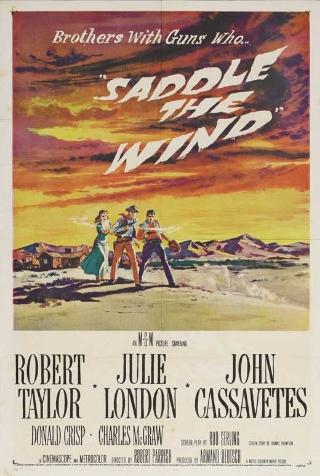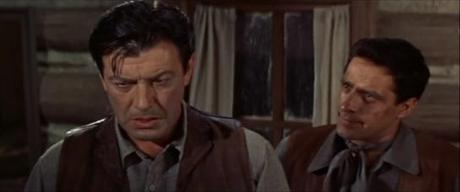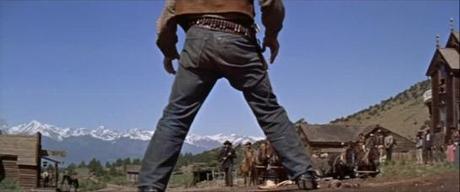
It’s a hell of a thing, killing a man. Take away all he’s got and all he’s ever gonna have. – Unforgiven (1992)
I decided to open with the above quote to prove a point of sorts. It’s a point about perception, the way cinema tricks us into believing certain things, or at least the way those who write about cinema shape our views. There are plenty of people who point to Eastwood’s Unforgiven and hold it up as the ultimate myth buster. I like the movie well enough but it does bring a wry smile to my face when I hear it lauded as a film which highlighted the corrosive effects of violence on men who lived by the gun. It’s easy to see how those unfamiliar with the genre, or even those with only limited exposure to it, could buy into the theory that Unforgiven is a bigger game changer than it really is. There is a tendency among some, probably fueled by the influence of the spaghetti western, to imagine the genre was all about cool, trigger-happy gunslingers prior to 1992. Somehow, the perception arose that the western shied away from or glossed over the consequences of violence and killing. Yet if one goes back to the golden decade of the 50s, it’s clear that the genre had already faced such themes head on. Saddle the Wind (1958) is a film about killing, a painful and probing examination of the repercussions of pulling a trigger and taking a life.
The opening sees a stranger (Charles McGraw) riding into town. He’s one of those bristly, hard-bitten types, the kind of guy who oozes insolence and aggression, who demands rather than asks. Men like this have a swaggering confidence born of the knowledge that they’re tough, mean and fast enough to carry it all off. Anyway, he makes it clear that he’s looking for a man, Steve Sinclair (Robert Taylor), and guys such as this don’t come looking for men just to be sociable. Steve Sinclair is now a respected rancher but he has a murky past that he’s trying to live down, having once been a famed gunman and killer. So what’s new, you may ask. Thus far the scenario is one that ought to be familiar to anyone who’s seen more than a handful of westerns. Well Steve is a man who has learned from the sins of his youth, he’s become a reformed character and has rejected violence. However, Steve has a younger brother, Tony (John Cassavetes), who appears to have inherited the worst traits of his elder sibling. Tony is more than just a cocksure kid with a gun and a point to prove; he’s a damaged human being, a walking stick of dynamite without a hint of remorse and a lust for killing. We first see Tony as he arrives home with a girl he intends to wed, former saloon singer Joan (Julie London), and a new gun. It’s immediately clear that there’s something itching away under Tony’s hide: he deposits his betrothed in the house, introduces her to all, and then proceeds to indulge his real passion. Where a normal guy would fawn and fuss over his newly acquired fiancée, Tony instead gets straight to work honing his shooting skills with his new six-shooter. Not only that, but there’s a manic, obsessive edge to his practice, rounded off by his blasting away at his own reflection in the water – which of course foreshadows the film’s climax. And this, more than anything else, is what the whole movie is really about, two very different brothers and their attitude to violence. The more Steve tries to rein in the excesses of his brother, the more Tony strains against that moderating influence. What finally brings the conflict to a head is the arrival of a former Yankee soldier (Royal Dano) bent on claiming his family’s legacy and stringing the dreaded barbed wire on the open range. Tony’s overreaction and stubborn refusal to heed Steve’s call for calm leads to a tragic confrontation. His neglect of Joan has already irritated Steve, but it’s his determination to usurp the authority of the local land baron (Donald Crisp) which finally forces the two brothers into a situation where only one can walk away.

Robert Parrish isn’t a director whose name will be familiar to many these days. However, he made a string of fine films throughout the 50s, culminating in the truly excellent The Wonderful Country. I recall reading somewhere that Parrish was unhappy that he wasn’t given full control over the final cut of that movie; I don’t know if that’s true but the fact remains his career as a director appears to have slumped dramatically after hitting that peak. Anyway, Saddle the Wind (with its screenplay by Rod Serling of The Twilight Zone fame) comes awfully close to being his best work – I reckon The Wonderful Country just about pips it to the post but there’s not a lot in it – with some memorable visuals and an extraordinarily powerful theme. Pitting brother against brother always makes for good drama. When you mix in the simmering resentment left over from the Civil War, and a scathing critique of machismo and the culture of violence then it all adds up to something quite special. It’s that last point which I mentioned in my introduction, and I’d like to explore it a little further here. Others have pointed out that the scene where Jack Palance gunned down Elisha Cook Jr in Shane was a pivotal moment in the development of the western, and I’m not going to argue with that. That proved that gun play and violence was a mean, dirty business. Saddle the Wind follows on from that and literally hammers the point home: apart from the heartfelt speeches delivered by Taylor and Crisp at various times, the killings that take place in the film, and there aren’t actually that many, are grim and brutal. No-one dies easily; as the bullets tear into bodies, the victims clearly suffer, twitching, kicking and coughing to the bitter end. And then there’s the aftermath, the consequences of taking a life. Two of the characters (Crisp & Taylor) bear the psychological scars of a violent past and their world view is shaped by that. For me, it’s this mature consideration of the effects of violence on the souls of men that marks Saddle the Wind out as one of the great westerns of the greatest decade of the genre.

The more often I watch Robert Taylor’s westerns, particularly those of the late 50s, the more I come to view him as one of the most significant figures in the genre. I didn’t include him in my list of the top ten western stars which I compiled at the tail end of last year, and I tend to think now that it may have been a major omission. I guess Taylor is never likely to attain the status of Stewart, Scott or Wayne but his finest western roles made a big contribution to the genre. In Saddle the Wind he achieved a marvelously quiet dignity, a kind of pained courage that projected all-round masculinity as opposed to juvenile machismo. Taylor’s calm awareness of his own strengths and weaknesses contrasts well with the strutting bravado of Cassavetes. Now there’s a figure one wouldn’t normally associate with the west. Cassavetes had a very urban and modern air about him, a guy who it’s hard to imagine outside of a big city environment. Yet that otherness, that discomfort with his surroundings, works under the circumstances. Cassavetes’ character is a young man at war with himself, and by extension with the whole world around him. If Cassavetes doesn’t truly belong in this frontier setting then it’s merely a reflection of the character whose psychological flaws and displaced morality set him apart from those around him. He honestly comes across as some unbridled force of nature, and Taylor’s futile efforts to tame him could easily be seen as a fruitless attempt at saddling the wind. These two men unquestionably dominate the film but it’s also important to mention the work done by Donald Crisp and Royal Dano. Crisp was always good in patriarchal roles and his benign presence in this movie is every bit as touching and influential as the rather different yet comparable part he played in Anthony Mann’s The Man from Laramie. Royal Dano was one of those character actors who seemed to pop up all over the place, and his halting delivery and hunted look tend to stick in the mind. Saddle the Wind offered him a role to get his teeth into, a desperate man driven on by his private sense of honor and justice. And that brings me to Julie London. Her fame today derives from her singing (and she provides a beautiful version of the theme song of this film) but she also starred in three exceptional westerns around this time: The Wonderful Country, Man of the West and the film under discussion.
Saddle the Wind was an MGM production and so it was released on DVD by Warner Brothers a few years ago in their Western Classics box set. The film has been given a very good transfer to DVD, the anamorphic scope image looking bright, clean and colorful. The location photography in Colorado looks quite stunning in places and the audio is also strong with the gunshots packing a considerable punch, and Elmer Bernstein’s brooding score sounding rich. The only extra feature offered on the disc is the theatrical trailer. I believe this is a very fine western, although nowhere near as well-known as it deserves to be. I see it as further proof of how far the western had progressed by the late 50s. However, the fact that thoughtful films like this are only infrequently mentioned can also be regarded as evidence of the regression the genre experienced through the following decade. Anyway, next time someone claims that a film such as Unforgiven broke entirely new ground in terms of its critique of violent lifestyles, you can simply point them towards this production and tell them it’s not as new a concept as they first imagined.
